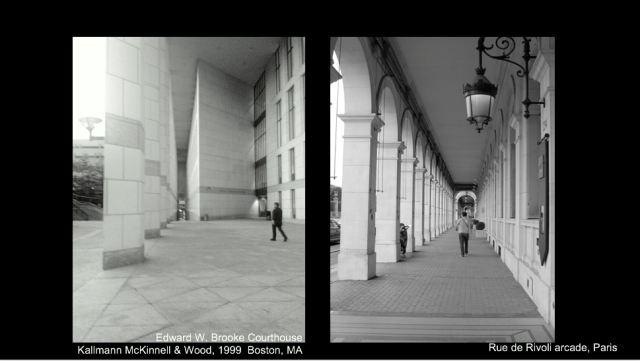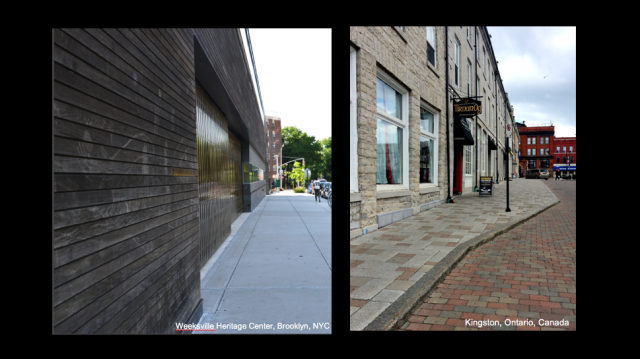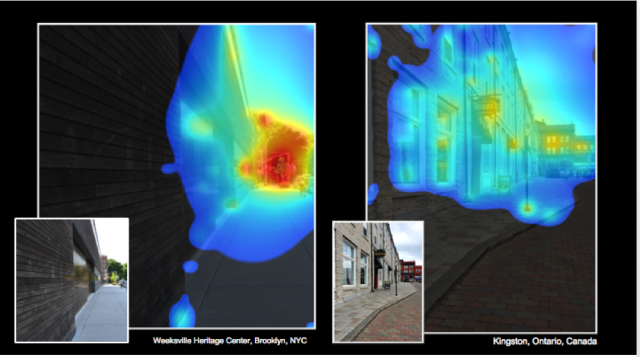 Here’s a question. In the photos above of two urban arcades, which one would you rather be in?
Here’s a question. In the photos above of two urban arcades, which one would you rather be in?
The image at left or the one at right? Don’t think too much – just choose!
In the last 24 months, I’ve had the chance to pose that same question to more than 1000 people while giving talks around the country.
And both the responses and response rates astonish. Quickly, without collaboration, everyone picks the image at right: the arcade in central Paris along the Rue de Rivoli, designed by Napoleon’s architects more than two centuries ago. (My hunch is you’d pick that too.) No one wants to be in the covered walkway in central Boston, built as part of a city court house about twenty years ago.
Here’s another preference test:
 Which street would you rather walk down? Both form part of historic centers, the one on the left in Brooklyn, NYC, the other, at right, in Ontario, Canada.
Which street would you rather walk down? Both form part of historic centers, the one on the left in Brooklyn, NYC, the other, at right, in Ontario, Canada.
I’ve shown this slide to more than 500 people. And again both responses and response rates astonish. Quickly, without collaboration, everyone picks the image at right: Market Street in the colonial port city of Kingston, Ontario. Given the choice, nobody wants to walk past recently refurbished Weeksville Heritage Center in Brooklyn, New York, an educational venue surrounding 19th-century historic homes.
How can this be? How do 500 or 1000 people so quickly make a decision about where to go, and all end up in the same place – without even speaking with each other?
The simple answer is our primate brains, hardwired to keep us safe, continuously and unconsciously scan the environment for survival. The images chosen subliminally feed the brain the stimuli needed to feel secure; the ones rejected don’t. Rue de Rivoli and Market Street give our brain what’s needed to move forward feeling at our best. The Boston Courthouse and Heritage Center in Brooklyn can’t. They never will.
Of course, how our brains select stimuli without conscious input is a larger question as is what our brains are preset to look for (some of this taken up elsewhere in this blog). Biometric studies add insight here; below is an eye-tracked version of the above street scenes created with 3M’s Visual Attention Software which indicates what gets people’s attention in pre-attentive processing (the first 3-5 seconds) taking in a scene.
 The ‘heat maps’ above glow brightest where people look instinctively, fading to black in areas ignored. The results suggest one reason the Brooklyn streetscape isn’t favored is our unconscious brain won’t let us look at it. And that’s huge because unconscious brain activity always lays the foundation for conscious behavior. It guides it. We don’t readily move towards or engage with a place our pre-attentive processing has determined is to be ignored.
The ‘heat maps’ above glow brightest where people look instinctively, fading to black in areas ignored. The results suggest one reason the Brooklyn streetscape isn’t favored is our unconscious brain won’t let us look at it. And that’s huge because unconscious brain activity always lays the foundation for conscious behavior. It guides it. We don’t readily move towards or engage with a place our pre-attentive processing has determined is to be ignored.
There are larger takeaways too, and here’s a key one: to build a sustainable future we need to build places people want to be, not places they don’t.
And this means we need to perennially pose one salient question: are we making places people will want to be – or not? And if not, why?

Pingback: How cities can use machine learning to track citizens
Pingback: Your city is watching you: How machine learning and “computer vision” will transform our cities | PATRICK SISSON
Pingback: Your city is watching you - Colossal Edifice
Pingback: Your city is watching you | Real Estate Marketplace
This post reports on how people in Houston, Nashville, Los Angeles, Boston, and elsewhere all said they preferred the same urban scenes; the technical term for asking people their feelings is known as ‘self-report’. What astonished us was near unanimity in the self-reporting NO MATTER WHERE PEOPLE LIVED!
How could this be? The eye-tracking analysis – using simple off-the-shelf emulation software – suggests one reason this happens is because the modern buildings don’t provide the ‘fixation points’ the brain needs to see in pre-attentive processing (first 3-5 secs before conscious brain can get into act) to put us ease. Yes, habit matters – just not as much as you think!
LikeLiked by 1 person
The heatmaps would be totally different for familiar places, or even for the second viewing of the exemplars.
Your methods are biased.
LikeLike
Off course, so what, no science is perfect. It is up to humans to draw conclusions from the science. Only logics and mathematics can provide 100% proof. This is a very complex field and these are simple studies making strong indications. I think this is great!
LikeLiked by 1 person
Pingback: Old mods hard-wired to ugly | Architecture Here and There